180th meridian
The 180th meridian or antimeridian[1] is the meridian 180° both east and west of the Prime Meridian, with which it forms a great circle dividing the earth into the Western and Eastern Hemispheres. It is common to both east longitude and west longitude. It mostly passes through the open waters of the Pacific Ocean, but passes across land in Russia, Fiji and Antarctica. This meridian is used as the basis for the International Date Line, but the latter deviates from it to maintain date consistency within the territories of Russia, the United States, Kiribati, Fiji and New Zealand.


Starting at the North Pole and heading south to the South Pole, the 180th meridian passes through:
| Co-ordinates (approximate) |
Country, territory or sea | Notes |
|---|---|---|
| 90°0′N 180°0′E | Arctic Ocean | |
| 71°32′N 180°0′E | Chukotka Autonomous Okrug — Wrangel Island | |
| 70°58′N 180°0′E | Chukchi Sea | |
| 68°59′N 180°0′E | Chukotka Autonomous Okrug | |
| 65°02′N 180°0′E | Bering Sea | |
| 52°0′N 180°0′E | Amchitka Pass | Passing just east of Semisopochnoi Island, Alaska, |
| 51°0′N 180°0′E | Pacific Ocean | Passing just east of Nukulaelae atoll, Passing just west of the island of Cikobia, |
| 16°9′S 180°0′E | Islands of Vanua Levu, Rabi, and Taveuni | |
| 16°59′S 180°0′E | Pacific Ocean | Passing just east of the island of Moala, Passing just west of the island of Totoya, Passing just east of the island of Matuku, |
| 60°0′S 180°0′E | Southern Ocean | |
| 78°13′S 180°0′E | Antarctica | Ross Dependency, claimed by |
The meridian also passes between (but not particularly close to):
- the Gilbert Islands and the Phoenix Islands of Kiribati
- North Island and the Kermadec Islands of New Zealand
- the Bounty Islands and the Chatham Islands, also of New Zealand
The only place where roads cross this meridian, and where there are buildings very close to it, is in Fiji.
Software representation problems
Many geographic software libraries or data formats project the world to a rectangle; very often this rectangle is split exactly at the 180th meridian. This often makes it non-trivial to do simple tasks (like representing an area, or a line) over the 180th meridian. Some examples:
- The GeoJSON specification strongly suggests splitting geometries so that neither of their parts cross the antimeridian.[2]
- In OpenStreetMap, areas (like the boundary of Russia) are split at the 180th meridian.
Notes
- The word antimeridian can also mean the meridian opposite to any given meridian. E.g. 20° west is the antimeridian of 160° east.
- "RFC 7946 - The GeoJSON Format".



